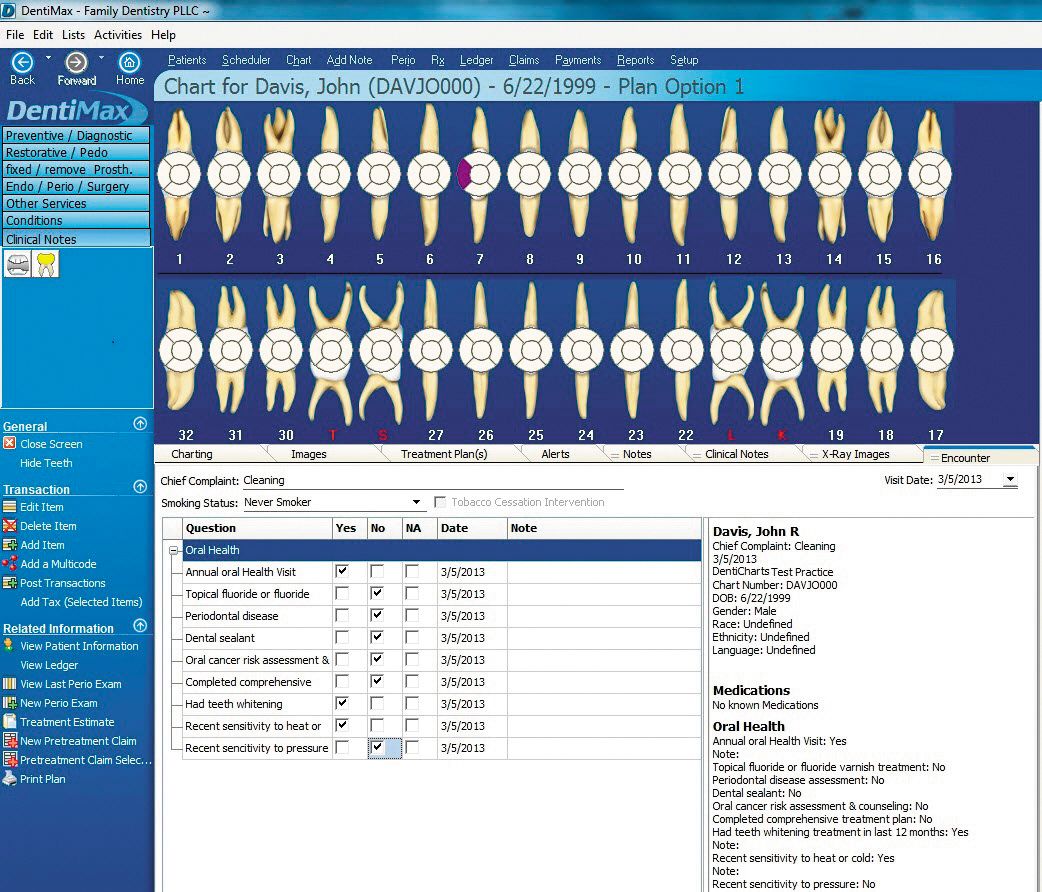How DentiMax practice management software improves efficiency for today’s clinician
When Dr. Anita Burkholder, MD, helped her husband, Dr. Rich Burkholder, DDS, set up his new dental practice in Newport Beach, Calif., she advised him to go electronic with his health records. She knew it was essential to embrace the future of dental practice management.
When Dr. Anita Burkholder, MD, helped her husband, Dr. Rich Burkholder, DDS, set up his new dental practice in Newport Beach, Calif., she advised him to go electronic with his health records. She knew it was essential to embrace the future of dental practice management.
“Futuristically, everyone is going to electronic,” she said. “So do it now or do it later.”
Joann Carr, from Dr. Robert S. Carr’s practice in Umatilla, Ore., agrees that incorporating electronic records is important to do now, particularly if you have patients who are on Medicaid or Medicare. Dr. Carr’s practice has a large percentage of these patients.
“The requirement at the end of next year is that anyone who sees Medicaid and Medicare patients must implement the meaningful-use standard with certified software to avoid payment reductions from Medicare. If you implement it early, the government offsets the costs,” she explained.
Getting reimbursement money requires certain qualifications and percentages to benefit from the program. If 30 percent of your patients are Medicaid-eligible, you can get up to $63,750 per licensed dentist. Carr explained it wasn’t as difficult to get the reimbursement as she thought.
“I was really surprised because a lot of people said it was going to be hard. The hard part for me was getting the reports right,” she said. “Once I had the data, it only took me 30 minutes to have it filled out and approved.”

Many clinicians are making the transition to practice management software for their practice. DentiMax Practice Management Solutions has a fully integrated and certified* electronic health records software built into its system. Burkholder chose DentiMax for its great charting capabilities and the medical records integration.
“When I looked at DentiMax, I saw it had not only great practice management utility, but, also, the clinical side was really good, too. There was incentive for me to choose them over the competition because I believe the two go hand-in-hand,” she explained.
Related reading: EHR software from DentiMax helps dentists get the most from government incentives
Both Carr and Dr. Burkholder like how it improves efficiency for their practices, each of which has a holistic approach to patient care. From patient treatment and health history to preferences for hygiene techniques and medications, the clinician can decide what information to include in the entry. Then, the software has tabs built in so you can access the information you need to know quickly.
“There is nothing worse than flipping through paper in front of the patient. It’s inefficient. It’s bad to be inefficient because in this day and age with the reimbursement being lower from insurance companies, people are trying to treat more patients. To do that without diminishing the quality of care, you have to be more efficient with your time. With electronic charts, you have tabs, and you aren’t looking for things,” she explained. “You can find things so much more quickly.”
Carr agrees. “The records are so much better. Anytime you have better records, you are going to have better care,” she said.
Continue reading on page two...
Dr. Carr’s practice has always embraced the move toward electronic health records. Adopting computer technology as early as 1982, he was one of the first to go chartless and electronic in the country and has been with
DentiMax
since 2006.
Burkholder recognizes some practices might be reluctant to adopt an electronic health records system because they fear the adoption process could be slow or painful. She says it doesn’t have to be. Her practice had a staff member who knew the program that would add the data and convert it. The staff member would look at the next week’s appointments and enter them the week before, so the information would be converted over time.
Trending article: Is your dental practice completely HIPAA compliant?
“It’s a process, but it’s not as bad as you think. Once you get a system down and do it over and over again, it doesn’t take as much time,” she said.
Carr likes how training occurs in the office at minimal expense. Other systems, she said, want to come in and train the whole staff for two to three days. She estimates trainings like that can cost a practice $20,000 to $30,000 in overhead and lost productivity. When you consider the turnover in staff most practices have, it isn’t practical. She described the DentiMax system as logical with questions to get the proper information.
“It’s easy to go from Point A to Point B. I can have somebody running a program in five minutes,” Carr explained. “Not that they can do everything the system has to offer in five minutes but at least enough to put in patient information and schedule appointments.”
DentiMax practice management software improves the patient care for the Burkholder practice as well. Burkholder explained that along with giving them easier access to the pertinent data, it also presents the treatment plan in the same file. This results in shorter appointment time.
Free E-Book: Simple ways to boost your practice image
“People have a hard time making time to go to the dentist. This system results in less time in the chair. Everyone likes that,” Burkholder said.
The Burkholders opted for a cloud-based system, mainly because she wanted to avoid housing a server and the related maintenance. She also likes that the upgrades are seamless and effortless. She also didn’t need to buy the software. In addition, she likes that the cloud gives her accessibility from any location.
Burkholder also advises practices to consider how the practice management system integrates with X-rays, digital imaging and intra-oral imaging. She chose the DentiMax system because it does these things, all from one company.
“In the end. if you want to run a successful practice, you want minimal costs, minimum vendors and all components of your electronic records-practice management, clinical and intra-oral-to integrate well,” Burkholder said. “The more you can put under one umbrella, the better for your practice. When things go wrong, you want it fixed quickly and all the brains under one roof.”
“This software is just amazing. It does everything but pick up the phone and call for you,” Carr agreed. “And they’re working on that!”
Trending article: 6 must-read articles for personal and professional success in 2015
*Certified software per ONC-ACB requirements to help providers meet Stage 1 and Stage 2 requirements for meaningful use.

